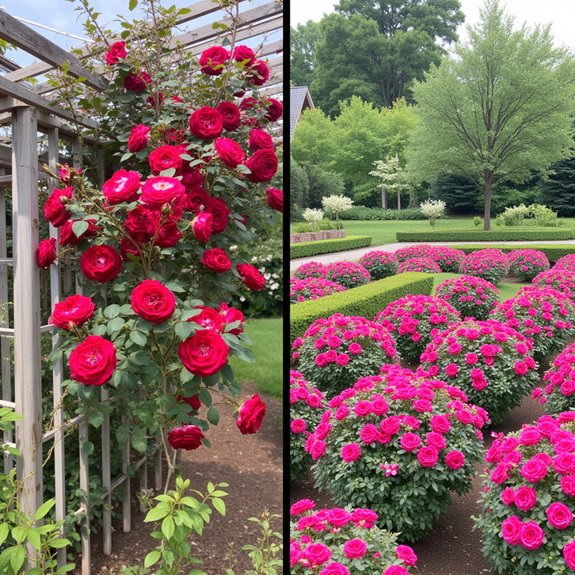Knock Out Roses have dominated garden centers since their 2000 debut, with over 75 million plants sold nationwide. These shrub roses promise disease resistance, continuous blooms, and minimal care—claims that sound almost too good for seasoned gardeners. Yet beneath the glossy marketing lies a more complex reality. Rose enthusiasts report unexpected challenges, from black spot outbreaks to disappointing fragrance levels, raising serious questions about whether these popular plants truly deliver on their bold promises.
Contents
The Rise of America’s Most Popular Rose

In 2000, a revolutionary rose variety burst onto the American gardening scene, forever changing how homeowners approached rose cultivation. William Radler’s decades-long rose breeding project culminated in the Knock Out rose, introduced by Star Roses and Plants after development throughout the 1970s.
The timing perfectly aligned with consumer trends favoring low-maintenance landscaping solutions. Garden centers embraced these hardy shrubs that promised continuous blooms from spring through frost in zones 5-11. Heavy marketing emphasized their disease resistance and drought tolerance, appealing to novice gardeners intimidated by traditional roses requiring intensive care and specialized knowledge.
What Makes Knock Out Roses So Appealing to Gardeners
Knock Out roses captured America’s gardening attention through a combination of practical benefits that address common rose-growing challenges. Their extended blooming season runs from spring through frost, providing continuous color for six months or more. This dramatically outperforms traditional roses that bloom in flushes.
Gardener accessibility remains their strongest selling point. These hardy shrubs thrive in poor soils, tolerate drought once established, and require minimal expertise to grow successfully. Garden centers stock them widely, making purchase convenient for novice gardeners seeking reliable results without extensive rose-growing knowledge or specialized care routines.

Despite their widespread popularity, Knock Out roses often disappoint gardeners who expect the robust performance their marketing promises. These hidden issues include loose flowers that shatter easily, minimal fragrance, and poor performance as cut flowers. Marketing tactics emphasize disease resistance, yet many gardeners discover their plants still require regular deadheading, fertilization, and pest management.
Rose Rosette Disease poses a serious threat, particularly when plants are neglected. The blooms lack visual interest compared to heirloom varieties, and their overwhelming popularity has overshadowed classic roses with unique beauty and historical significance.
Disease Resistance Claims vs. Reality
How accurately do Knock Out roses live up to their disease-resistant reputation? The reality proves more complex than advertisements suggest. While these roses show improved resistance compared to traditional varieties, they’re not immune to common problems like black spot, powdery mildew, and aphid infestations.
Marketing tactics often emphasize “disease-resistant” rather than “disease-proof,” creating unrealistic expectations among gardeners. Disease prevalence varies considerably based on climate, soil conditions, and maintenance practices. Rose Rosette Disease poses a particularly serious threat, potentially killing entire plants within two seasons despite their marketed hardiness.
Why Rose Purists Are Pushing Back

While Knock Out roses dominate garden center displays, traditional rose enthusiasts express growing concern about their impact on horticultural diversity. These purists argue that mass marketing overshadows centuries-old varieties with unique characteristics, complex fragrances, and cultural significance. Rose aesthetics matter deeply to collectors who prize the intricate petal formations, rich scents, and historical stories that heirloom roses carry.
The push for easy-care gardening threatens heirloom preservation, as nurseries stock fewer classic varieties. Enthusiasts worry that beginner gardeners, satisfied with basic blooms, won’t explore the remarkable diversity of tea roses, damasks, and gallicas that shaped garden history for generations.
Exploring Superior Alternatives to Knock Outs
Gardeners seeking roses with character and performance have numerous options that surpass Knock Outs in fragrance, beauty, and disease resistance. Superior varieties like ‘The Fairy’ offer delicate pink blooms in zones 5-11, reaching 2-4 feet with excellent shade tolerance. ‘Easy on the Eyes’ provides lavender-pink flowers with citrus and spice fragrance that Knock Outs completely lack.
For climbers, ‘William Baffin’ stretches 7-10 feet tall, thriving in harsh zones 2-9. These alternatives showcase unique characteristics including stronger scents, better flower form, and often superior hardiness. Each variety brings distinctive appeal that mass-marketed Knock Outs simply cannot match.
Making the Right Choice for Your Garden
Successful rose selection depends on matching plant characteristics to specific garden conditions, maintenance preferences, and aesthetic goals. Consider your available space, soil quality, and sunlight exposure before choosing varieties. Proper planting techniques matter less than selecting roses suited to your climate zone and garden layout.
Garden aesthetics play an essential role in decision-making. Knock Outs offer reliable color but limited fragrance, while alternatives like ‘The Fairy’ provide delicate blooms in zones 5-11. Evaluate your maintenance commitment honestly. Low-maintenance gardeners benefit from disease-resistant varieties, whereas dedicated rosarians might prefer heirloom types requiring extra care but delivering superior beauty and historical significance.
